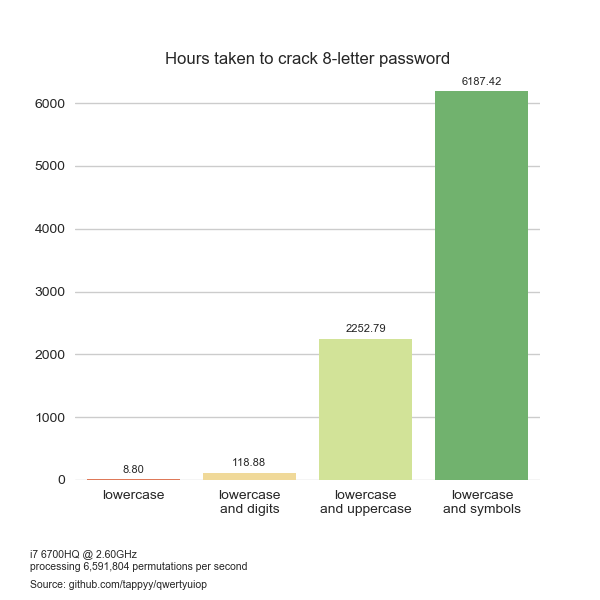Multi-processing to speed up benchmark testAdd option to input thread number (processes)- Create visualisation of single thread vs multi-thread
Find the approximate crack time of a password by performing a brute force attack and outputting the results to a .csv file for visualisation.
Perform a brute force attack on a randomly generated 10-character password. Once the benchmark guess limit has been reached, a guesses per second rate is calculated.
Sample space is calculated based on characters contained in the password.
- alphabet lowercase (a-z) = 26
- alphabet uppercase (A-Z) = 26
- numerics (0-9) = 10
- non-alphanumerics (!?£$%^ etc) = 33
Example:
g!thu8 contains characters from lowercase, numerics and non-alphanumerics.
sample space = 26 + 10 + 33 = 69
permutations = sample space ^ length of password = 69^6
permutations = 107918163081
Using the guess rate per second and total number of permutations, the crack time is calculated.
crack time = permutations / guess rate = 107918163081 / 6552832
crack time = 16468.93 seconds or 274.48 minutes or 4.57 hours.
Once all passwords in the file have been analysed, a .csv file is created containing the following information:
- Password
- Crack time (hours)
- Crack time (days)
- Permutations in short form Eg. 69^6
Seaborn - Used for data visualisation
Install Seaborn and its dependencies with the following command:
pip install seaborn
Recommended usage is as follows:
python qwertyuiop.py -i file.txt -o results.csv
-i - .txt file containing a list of passwords to analyse - required
-o - .csv file to output the results to.
-b - Perform a new benchmark test using this number of threads. (default = 4) - optional
-h - For when you get stuck :)
Note: For the best results, perform a benchmark with as few processes running as possible.
Thanks to ScottSmudger for the regex help!
Inspired by https://github.com/dwolfhub/zxcvbn-python
